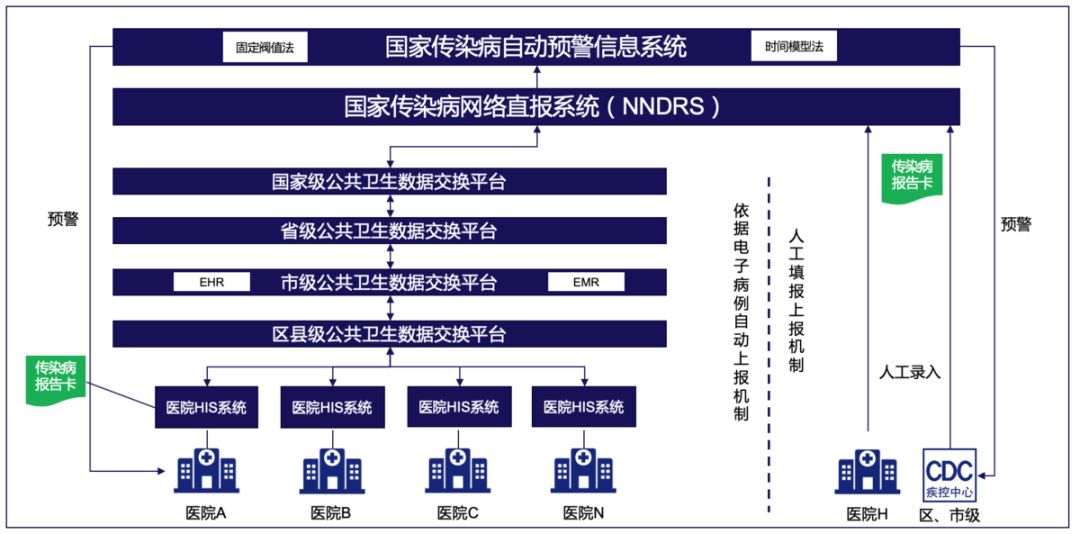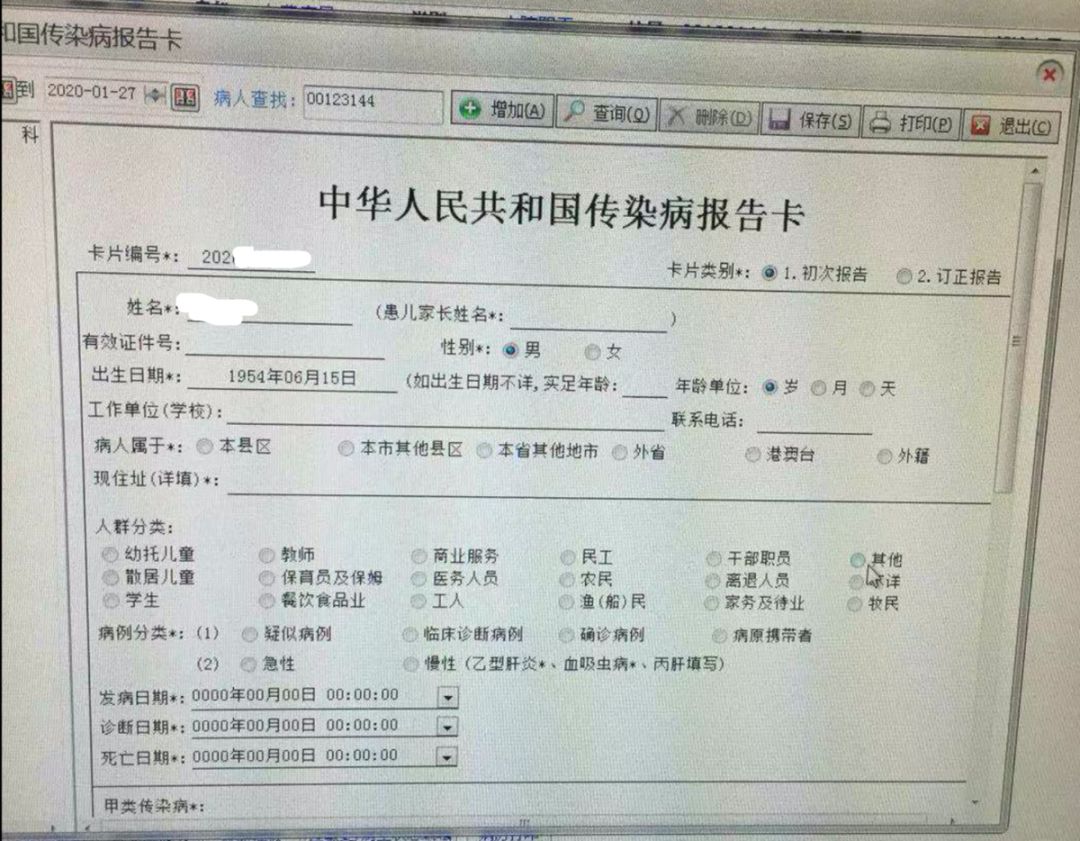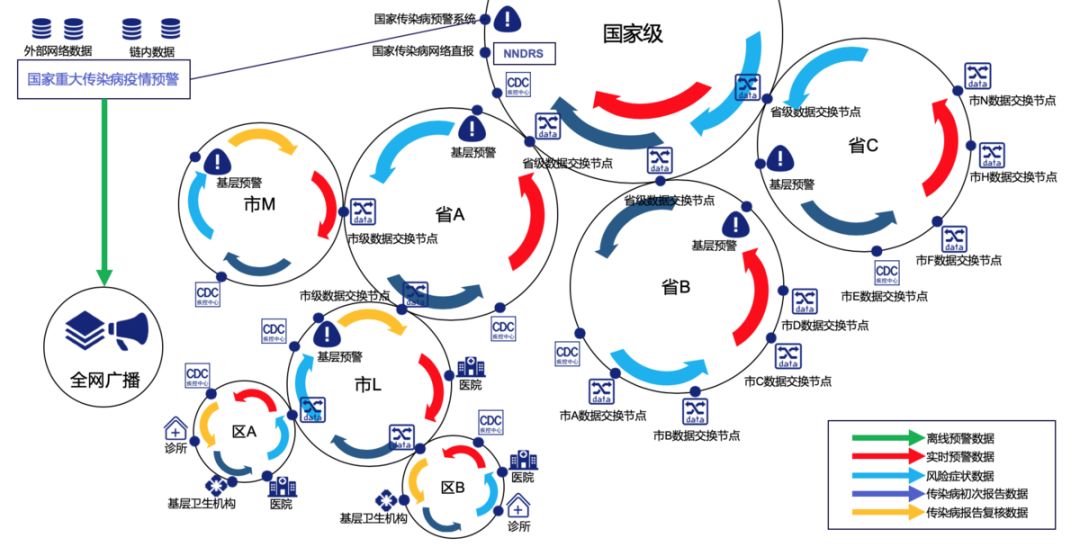Hardcore! Blockchain helps to warn of infectious diseases!
Author: Wu Shi children
Source: Everyone is a product manager
In the Spring Festival of 2020, new coronary pneumonia affects everyone's heart. What can we do as connected people in this battle? In this article, the author tells us from a professional perspective that there are many things we can do.
2020 is bound to be an extraordinary year.
- Explain the centralization, distribution, decentralization, and state machines in Trisomy from the epidemic prevention and control
- Swiss authorities "no longer friendly" to cryptocurrencies? New regulations require crypto transactions over $ 1,000 to be reviewed
- Japan's Financial Services Agency: Crypto investment vehicles are not investment trusts
With this complex mood, I decided to write this article. The latest national statistics of new coronavirus infection pneumonia data are:
By 19:26 on January 29, 2020, China (including Hong Kong, Macao and Taiwan) has confirmed 6081 cases, died of 132 cases, and cured 116 cases. Most of the provinces except the Tibet Autonomous Region have been infected—the spread of the epidemic situation, until Follow SARS of the year.
You should know: SARS was 17 years ago, and now regardless of domestic medical infrastructure, sanitary conditions, or supporting epidemic management software, it has made rapid progress, and automatic warning and epidemic prevention of infectious diseases have reached the international advanced level. I ca n’t believe how At the beginning of spring 2020, the outbreak was so rapid and so unexpected.
With curiosity about the domestic epidemic prevention system, the author consulted a large amount of literature on the disease surveillance network to try to find the reason for the failure to prevent and control the epidemic in a timely manner.
Because the author is not a medical staff, this article does not explain how to prevent and treat coronavirus; not a government worker, not Weibo Da V, so I do not talk about the merits of the incident; the author is only an IT technical worker, I tried to pass technical and systematic From a perspective, to review and analyze the current status of the automated reporting and early warning system of infectious diseases in China. It is hoped that new technologies and new structures will be adopted to improve the transparency and timeliness of infectious disease surveillance and early warning.
More importantly: the author is a citizen of the country and has the right and obligation to contribute his strength to participate in the state and social governance.
If there is a deviation in the professional system part of the article, please correct it in time, thank you!
Related nouns: National Automatic Infectious Disease Early Warning Information System, Infectious Disease Report Information Management System, Hospital Information Management System (HIS), National Infectious Disease Network Direct Reporting System (NNDRS), Public Health Data Exchange Platform, Public Health Management Information System, ICD -10 diagnostic code, population health information platform, infectious atypical pneumonia (SARS), electronic health record (EHR), electronic medical record (EMR), National Center for Disease Control and Prevention (CDC)
Situation Analysis
Current reporting and surveillance status of infectious diseases in the country:
In April 2008, China launched an automatic national early warning system for infectious diseases in 31 provinces (municipalities, autonomous regions) and established an automatic early warning and response mechanism; it has realized automatic analysis of surveillance data for 39 infectious diseases and real-time spatial and temporal aggregation Functions such as identification, early warning signal transmission and real-time tracking of response results are currently in the advanced position in the world.
At the same time, in addition to the national infectious disease automatic warning system, China has also successively built a national infectious disease report information management system and its core subsystem, the National Infectious Diseases Network Direct Reporting System (NNDRS), to achieve legal infectious diseases based on medical institutions. Real-time, online, direct reporting of cases;
In order to improve the completeness and accuracy of the monitoring data, to achieve standardized and unified collection of data such as electronic health records (EHR) and electronic medical records (EMR), a four-level population health information platform and its data exchange platform (area) have also been piloted and run. , City, province, country);
In order to reduce the difficulty of filling out the infectious disease report card by the doctor, the hospital opened the HIS system and the direct report system, and the infectious disease report card was semi-automatically submitted through the medical record automatically popping up or manually opening the filling page.
Specific system architecture
As the construction situation in different provinces across the country is not exactly the same, I use the above picture as a reference to highlight the specific process of reporting the current national infectious disease report:

Current reporting and early warning structure of infectious diseases in China
In some well-established provinces, semi-automatic and manual infectious disease report uploading methods can be supported. Doctors can use the hospital's HIS system to automatically pop up infectious disease reports when filling in electronic medical records. Level public health data exchange platform, after supplementing the data format and completeness (electronic health card and electronic medical records), it was finally collected into the National Infectious Diseases Network Direct Reporting System (NNDRS), and the National Infectious Diseases Early Warning System passed these infectious disease reports Card, using fixed threshold method and time model method (mobile percentile method, cumulative and control chart method, clustered epidemic method) to calculate and monitor and analyze 39 epidemic conditions of infectious diseases on a daily basis and report to the primary hospital and CDC Early warning.
Report specific business processes
Let's take a look at the approval process reported by the infectious disease report card:
After the infectious disease is discovered by the clinician, the infectious disease report card is filled in semi-automatically or manually, and then submitted to the hospital for review. After being reviewed by the in-hospital defense doctor, it is submitted to the district, county, and city-level disease control centers for review and supplementation. The health data exchange platform was sent to the National Infectious Diseases Network Direct Reporting System.

Note: The picture is from Kong Yuanyuan, Gao Guiling, Zhang Qinghui, Guo Xiaoqin Practice of Infectious Disease Epidemic Report and Management Information System Directly Based on Hospital Electronic Medical Records 2019
Regardless of the system structure or the review and submission process of the infectious disease report card, they are uploaded and promoted layer by layer, and hierarchical management is achieved.
The structure of the uploaded infectious disease report card is as follows:


Infectious disease report card in HIS system of a basic hospital
Why is there no warning this time
The infectious disease surveillance system in China has evolved from the old manual reporting method to an IT-based and information-based reporting method, which has basically achieved the aggregation and monitoring of 39 infectious disease data across the country.
Compared to SARS in 2003, it is indeed a very big improvement, but the real problems are:
Why is the National Automated Early Warning System for Infectious Diseases dumb before this major outbreak?
The author has carefully read the relevant papers and literature of the "Disease Surveillance Network", and analyzed and concluded that the current national infectious disease reporting and early warning mechanism in China has serious hidden dangers for the new major outbreaks. The specific problems are as follows:
The infectious disease report card is actually a judgment result of the known ICD-10 diagnostic code, and the confirmation period for new diseases is long.
As you can see from the above figure, the current national infectious disease report card is triggered based on the ICD-10 diagnostic code. It is a report of 39 known infectious diseases. For new infectious diseases, it is necessary to repeatedly verify and confirm. The reporting period is long. .
Although there are suspected reporting options in the report card, each doctor, each hospital, and the local CDC bears the pressure of the accuracy of the corresponding individual and institution to report the suspected cases without a certain degree of certainty The report itself is a kind of guts (Note: The National Centers for Disease Control and Prevention only launched the new pneumonia detection function of the new coronavirus pneumonia emergency on January 24, 2020).
The infectious disease report card needs 3 levels of manual approval from discovery to reporting. Whether the report is successful or not, there are too many human interference factors.
At present, the infectious disease report card will be reported to the National Infectious Diseases Network Direct Reporting System after completing the report by the clinician. It will also require 3 manual approvals, namely: in-hospital health insurance review, district and county CDC review, and city-level CDC review. Central audit.
Why are there so many manual reviews?
It is mainly based on the completeness and accuracy of data reported by national infectious diseases.
The use of multiple agencies and personnel to verify and approve is a very safe and secure way; but it is a major shortcoming in monitoring the outbreak of major infectious diseases.
Once an infectious disease appears early, stability from the local government, economic pressure and public pressure may affect the smooth reporting process.
The infectious disease report card originally served the early warning and surveillance of infectious diseases, but its structural nature hindered the response to major outbreaks of surveillance.
The early warning model of the National Infectious Diseases Early Warning System is essentially a rule model, which can only detect and warn of known diseases.
In 2008, China operated the national automatic warning system for infectious diseases and established an automatic warning and response mechanism. The early warning data comes from the data reported by the national infectious disease report card step by step.
The early warning model is mainly divided into two kinds of fixed threshold method and time model method. The fixed threshold method is an event model that sets the threshold of the number of occurrences of 15 major infectious diseases. : Moving percentile method, cumulative and control chart method, cluster epidemic method, is the detection of 18 infectious diseases, and its essence is to increase the historical statistical analysis of time and space dimensions. Early warning.
At present, the early warning model of the infectious disease early warning system in China is not a conditional model based on big data analysis, but only a judgment model based on the result rule of the infectious disease report card.
The rule judgment model must be a judgment and early warning of known infectious diseases, so it has basically no effect on new types of major infectious diseases.
The reporting of national infectious diseases is a step-by-step review and summary report, which lacks transparency and is deficient in responding to sudden large-scale infectious disease epidemics.
National infectious disease reporting is a method of level-by-level aggregation of the national direct reporting system after the clinician finds and fills in the infectious disease report card and passes hospital audit—> district CDC audit—> city CDC audit—> three-level data exchange platform—> national direct reporting system; There are many levels of aggregation, and manual data supplement and review processes are cumbersome. This is okay for daily data management.
In addition, there is a lack of data comparison of patients with the same symptoms between hospitals. Infectious disease report cards are only uploaded vertically, and there is no horizontal information sharing. For the prompts and early warning of other hospitals, only the national automatic warning system for infectious diseases can be used.
Improved suggestions
Optimize the current gradual vertical one-way national infectious disease reporting network, and use the blockchain fragmentation mechanism to establish district, city, provincial, and national four-level blockchain automated data synchronization networks, relying on disease at all levels in the four-level network Control center to establish autonomous capabilities for data collection and real-time early warning of sudden infectious diseases, and does not fully rely on national infectious disease early warning systems.
The existing public health data exchange platform is used as an exchange node for each level of data to form a real-time automated data exchange mechanism.
The infectious disease report data between the districts is synchronized in the municipal epidemic prevention chain; the infectious disease report data between the cities is synchronized in the provincial epidemic prevention chain; and so on, the national epidemic prevention data is synchronized to the national level.
Like the four wheels, the four-level epidemic prevention chain automatically completes the internal epidemic prevention and warning work in all districts, cities, and provinces, and continuously updates and supplements the data of other provinces through the national level epidemic prevention chain to form an epidemic prevention network with certain regional autonomy.

Four-level epidemic prevention chain
The details are as follows:
Establish a two-wire asynchronous parallel process for the initial registration and reporting of infectious disease report cards, manual verification, and post-replenishment
The current serial process of filling, supplementing, verifying, approving, and reporting infectious disease report cards is changed to the two-line asynchronous parallel process of initial registration and reporting, supplementation, verification, and approval of infectious disease report cards.

Infectious disease report card asynchronous parallel process
At present, the national infectious disease reporting system requires data integrity and accuracy of infectious disease reports to be too high, so it can only be verified step by step, supplementary information and review, so as to delay the best time to report infectious diseases.
We all know that the misreporting of infectious diseases will have a great impact on the local government's economic and social stability. This is also the main reason why we now prefer a more secure serial audit reporting model; but the serial audit reporting model Responsibility and pressure for reporting are all in the doctor, hospital and local CDC, so it is very likely to be affected by government and human intervention, concealing and delaying reporting.
As we all know, the early warning model based on big data does not make strict requirements on the completeness and accuracy of singleton data. The scale, scope and timeliness of data are the core of big data early warning of infectious diseases.
Therefore, it is recommended that the authority to report infectious diseases be relaxed at the beginning. Doctors and primary medical institutions can directly report the initial infectious disease report card. Afterwards, the insurance doctor and the district and city CDC staff will verify and supplement the report card. Big data early warning can use the initial infectious disease report card to calculate the outbreak and spread trend of infectious diseases in advance, so as to carry out early warning and preparation.
Separate medical records and examination report data to increase the collection of data on risk symptoms of infectious diseases
The infectious disease report card is conclusive in nature, and it takes a lot of time to determine whether it is suspected or confirmed.
After establishing a conditional early warning model of big data, in addition to collecting infectious disease report card data, infectious disease risk symptom data can also be separated from medical records and inspection reports for automatic identification and reporting.
It is recommended that the national infectious disease direct reporting system increase the collection of infectious disease risk symptom data. Infectious disease risk symptom data such as fever, chest radiograph description, cough, and biochemical indicators can be separated and identified through unstructured data analysis. The key is Infectious disease risk symptom tags are automatically uploaded through a four-level health and health data exchange node.
Because it does not directly upload infectious disease report cards, it has no direct impact on social stability and the economy. For big data early warning, the scope and scale of data can be increased, and early warning accuracy can be improved.
In addition, the reporting of infectious disease risk symptom data shifts the pressure from doctors, hospitals and local CDCs to the fourth-level health and health data exchange node, and replaces manual reporting with automation, reducing the burden of responsibility at the grassroots level.
The big data condition analysis model is used to supplement the original regular event model to establish a national and grassroots two-level early warning network.
As mentioned above, the current national automatic warning model for infectious diseases is actually a rule model. The rule model has only an early warning function and no predictive function.
It is suggested that the National Automated Early Warning System for Infectious Diseases establish a set of "Big Data Condition Analysis Models" as offline forecasting and early warning support libraries, and collect "infectious disease risk symptom data" and "Internet data" other than "infectious disease report cards".
For example: air ticket booking, drug supply, search data, etc., to build a national top-level off-line early warning network for infectious diseases.
At the same time, relying on the real-time synchronization capability of the four-level epidemic prevention chain data, the establishment of a rule model-based data real-time judgment and early warning capability through the smart contract of the blockchain; the current national automatic infectious disease alert function is sunk to the district, city, and provincial epidemic prevention chains In order to form a grassroots real-time early warning network.
The national top-level off-line early-warning network of infectious diseases and the real-time early-warning network at the grass-roots level work together at the same time, which can take into account both the real-time nature of the warning and the ability to predict big data.
Establish a distributed, point-to-point, infectious disease report data sharing network based on hospitals and local CDCs.
District, county-level hospitals, district CDCs, and municipal CDCs are currently the basic windows for reporting infectious diseases. Hospitals and CDCs have the obligation and responsibility to report cases of infectious diseases, and are the basis for the country's overall surveillance, early warning, and control of the epidemic.
However, for the hospital to judge the overall situation of the current epidemic situation, it can only be reported from the top to the bottom through the CDC statistics of infectious disease reports collected by each level.
We know that outbreaks of major epidemics often have sudden characteristics, and in the early stages of an epidemic, reporting data horizontally across multiple hospitals and regions at the first time will greatly enhance the confidence of doctors and hospitals to report epidemic situations. Medical workers provide awareness of the epidemic situation, and the preparation of material protection in advance provides the basic guarantee.
It is recommended to build district, city, province, and national blockchain epidemic prevention chains, to achieve automatic synchronization of epidemic data across hospitals and regions, and to achieve cross-regional and hierarchical data through four-level health and health data exchange nodes in the four-level epidemic prevention chain. exchange.
The single chain achieves data synchronization in the region through the data synchronization capability of the blockchain automation node; the four-level epidemic prevention chain can achieve a certain level of autonomous early warning capabilities through smart contracts, and can control the epidemic situation and scope in the region early in the outbreak.

Grassroots autonomous warning
Establish a report-responsibility storage mechanism based on blockchain for tamper resistance and transparency.
We do not want a major outbreak, but in addition to actively controlling the epidemic, curing patients, and eliminating the adverse social and economic impacts of the epidemic, we must also actively summarize lessons learned after the outbreak.
We need a complete accountability system, and we need to provide ordinary people with a data basis for transparent supervision and event accountability. Whether it is a hospital, local CDC, or government administrators, they can self-tamper through the blockchain's anti-tampering and transparency features. Card one or two.
Regardless of admission, suspected treatment, confirmed diagnosis, death or report, all can be carried out under the supervision of ordinary people and superior competent governments. Once a major epidemic is held accountable, it can rely on the traceable characteristics of blockchain data to form a complete, tamper-resistant The chain of responsibility can greatly enhance the credibility of the government and provide a solid mass foundation for epidemic prevention and control.
to sum up
The author has experienced the SARS epidemic in 2003. In the past 17 years, I have seen the country's rapid progress in the construction of information technology and mobile Internet technology. I don't believe that with the current technical means, we cannot fully respond to the early warning and control of major infectious diseases. Know: This outbreak and the SARS era are at two completely different levels of information technology and automation technology).
The relevant administrative departments of our country must dare to accept and dare to try new technologies, and use technology to arm the epidemic prevention system of major epidemics-after all, in the face of death, everything else is secondary.
We will continue to update Blocking; if you have any questions or suggestions, please contact us!
Was this article helpful?
93 out of 132 found this helpful
Related articles
- Mankind's largest collaboration, "epidemic" and blockchain thinking
- IMF advises Eastern Caribbean countries to try digital currencies
- The Secret History of Bitcoin: The Story Behind the Bitcoin Logo?
- DeFi locks up to $ 1 billion milestone but cannot be taken lightly
- Beijing launches 7 new application scenarios of "blockchain + real estate registration"
- A new narrative of Bitcoin value: it will obsolete all other currencies
- The total value of DeFi hedging exceeds US $ 1 billion, and the rise in ETH price is not the only reason





